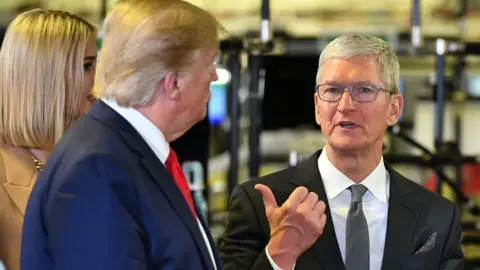Apple Inc., a titan of innovation in the technology sector, has announced plans to invest a staggering $100 billion (£75 billion) in the United States. This decision comes in response to pressure exerted by President Donald Trump, who has been vocal about his desire for American companies to produce more goods domestically. The investment aims to encourage U.S. manufacturing of Apple components, which would complement the company’s earlier commitment to spend $500 billion in the U.S. over the next four years.
The investment announcement follows a series of warnings issued by Trump earlier this year, where he explicitly pointed out Apple. He threatened to impose higher tariffs on its products unless the company relocated more of its iPhone manufacturing to the U.S. This political backdrop has induced Apple CEO Tim Cook to express a readiness to “do more” in light of the looming tariffs, which could significantly impact the company’s finances.
The White House commended Apple’s announcement, stating it represented a broader trend of businesses responding positively to Trump’s pro-American manufacturing policies. In a statement released on the same day, a White House spokesperson described the pledge as a “win for our manufacturing industry” that would bolster the U.S. economy and national security by reshoring critical production components.
Despite the optimism surrounding this investment, analysts maintain that any major shift in Apple’s supply chain will take time to materialize. They have noted that the company has long relied on China for the production of the majority of its products but has started adapting its supply chain to mitigate the effects of new tariffs introduced by the Trump administration. Over the past months, Apple has started transferring some manufacturing duties to countries like India and Vietnam—nations that face lower tariffs on exports to the U.S.
However, the financial implications of these tariff policies have begun to show. Apple reported that it incurred over $800 million in new taxes associated with border tariffs during the last quarter, reflecting the weight of Trump’s extensive tariff regime initiated earlier in the year. Furthermore, the company anticipates an additional $1.1 billion in tariff costs in the upcoming months, despite having received exemptions for certain electronics.
The proposed new tariffs on goods produced in India, set to increase to 50%, further complicate Apple’s efforts to manage costs and avoid additional taxes. Additionally, discussions of new tariffs targeting the semiconductor industry loom as a potential threat on the horizon.
Amidst this complex political landscape, Tim Cook’s historical ties to the Trump administration have drawn attention, as he personally contributed $1 million to Trump’s inaugural committee. During discussions with investors, Cook highlighted the company’s ongoing U.S. commitment and its collaborative investment strategies with third-party manufacturers. He referenced initiatives such as a planned “manufacturing academy” in Michigan and a prior investment of $500 million in MP Materials, a company focused on expanding U.S. production of rare earth elements critical for technology.
Trump has frequently used high-profile commitments from major corporations to underline the success of his administration’s economic policies, though experts have raised questions regarding the accuracy of the figures presented and whether they indicate a sustainable trend. Paolo Pescatore, a prominent analyst, noted Cook’s adept steering of Apple through challenging times while expressing skepticism about the feasibility of rapidly shifting all manufacturing to the U.S.
In conclusion, while Apple’s announcement of a $100 billion investment signifies a positive shift in American manufacturing prospects, the realities surrounding the practicality of such a shift remain complex and subject to the volatile political and economic climate dictated by tariff policies and international relations. Cook’s strategic navigation of these challenges will be critical for the future landscape of Apple’s production and operations.











